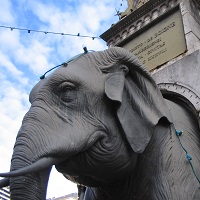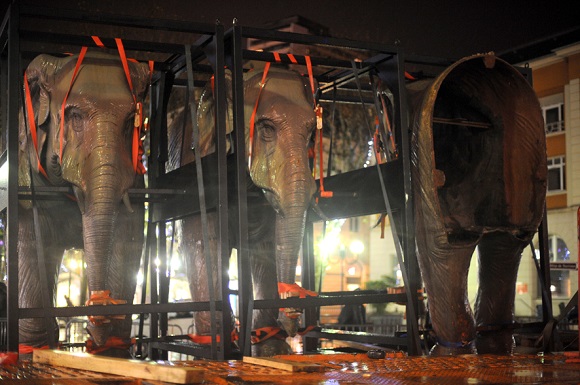
Imagine if Paris disassembled the Eiffel Tower to recast its iron or Carcassonne dismantled its ramparts to recut the stone and you can understand the visual trauma to the small city of Chambery in the foothills of the French Alps when the four beloved pachyderms of the Fountain of Elephants were removed, placed in a truck and taken to a foundry near Lyon to be restored.
The removal occurred on Dec. 17, leaving the city’s most emblematic monument both dry and naked.
Chambery’s Fountain of Elephants may not embody the pinnacle of local architecture, the General/Count de Boigne, the mercenary-cum-philanthropist to whom it is dedicated, may not represent the summum bonum of virtue, and it isn’t as though the city has no other attractions. Nevertheless, in the absence of photogenic signs of Chambery’s role as the former seat of power of the House of Savoy, beyond its flag, the Fountain of Elephants is as fine a symbol as any of this most pleasant small city of some 60,000 inhabitants.
Furthermore, the fountain’s got a great and evocative nickname: “Les Quatre sans cul,” meaning the assless four. Only the head and forelegs of the four elephants exist. For now though, through the winter of 2014-15 and well into spring, the four will not only be without derriere but absent altogether. Two of them may need to be completely recast.
Here’s a video showing the dismantling of the elephants.
Who was General de Boigne?
Born in Chambery, Benoit Leborgne (1751-1830), later known as Comte and General de Boigne, had a storybook life of a soldier, traveler and hometown benefactor. As a soldier he worked under various states and organizations, alternately Irish, French, Sardinian, Russian and Indian. In 1796 he left India to live in London before returning to Chambery in 1801.
Having gathered a sizeable fortune along the way, particularly while at the service of the Maratha Empire of India, he donated significant funds to charitable organizations and for projects to embellish the city, including for the construction of homes for the aged and indigent, Chambery’s theater and the arcaded street that now bears his name. It was therefore fitting that Chambery would return the favor with a (not-too-expensive) monument to his memory, created by Pierre-Victor Sappey and inaugurated on Dec. 10, 1838.
American planes bombed Chambery on May 26, 1944 in order to prevent Germans troops from going to/from Italy during the final days of the Allied preparations for the Invasion of Normandy. The railway station and about a third of the town were destroyed, but de Boigne and his Assless Four survived, furthering the fountain’s symbolic value in a wounded city.
This is the first major restoration to the fountain since the early 1980s. The anticipated total cost of the operation is 1.2 million euros, with 40% being paid for by the Regional Department for Cultural Affairs (DRAC), 19% by Savoie/Savoy (the department) and the rest by the city and by private donation.
Already in the fall of 2013 the statue of the philanthropic general atop the column that soars over the fountain was removed for a thorough cleaning. The column and pedestal having been solidified in the meantime, the general soon returned with a golden bronze sheen that was then treated to return him to the patina of old age. It’s likely though that few Chamberians missed de Boigne during his absence since it’s the elephants that are the true stars of the monument.

The elephants will begin their trek back to the fountain in May 2015, when they’ll return to their slots surrounded by restored bas reliefs telling about de Boigne’s military exploits and his benevolence toward his hometown. The full project isn’t expected to be completed until June, however. Then the water will again spout from their trunks and the city will once again be whole, if assless.
© 2014, Gary Lee Kraut
Chambery is 2:50 by train from Paris. By car, Chambery is 1 hour from Lyon, 45 minutes from Geneva or Grenoble, 30 minutes from Annecy. For official tourist information see www.chambery-tourisme.com.
Also see this article about Chambery on France Revisited.

